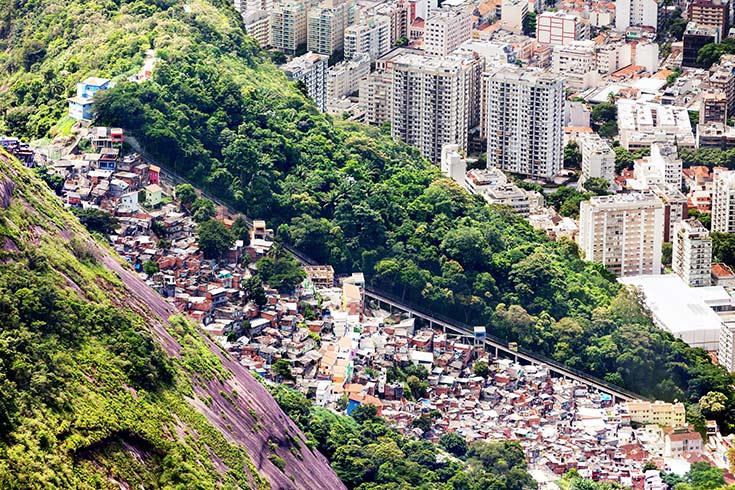Financing resilient cities of the future
Natural disasters – such as Hurricane Matthew – and climate change are having devastating effects on cities and the four billion people who live in them today.
By 2030, without significant investment into making cities more resilient, natural disasters may cost cities worldwide $314 billion each year, up from around $250 billion today, and climate change may push up to 77 million more urban residents into poverty, according to a new report by the World Bank and the Global Facility for Disaster Reduction and Recovery (GFDRR).

High density of people, jobs and assets make cities succesful, but also render them vulnerable to natural and human-caused shocks and stresses (Leung Cho Pan / 123rf)
Released ahead of the UN Conference on Housing and Sustainable Urban Development – or Habitat III – taking place in Quito, Ecuador, October 17 – 20, the Investing in Urban Resilience report cautions that rising numbers of natural disasters, as well as a growing number of economic, social, and environmental shocks and stresses, pose the greatest risk to rapidly-growing cities.
Home to 55 per cent of the world’s population, urban areas are the engines of global growth, contributing to 80 per cent of global GDP. However, the high density of people, jobs, and assets that make cities so successful, also makes them – and global industry – extremely vulnerable to the wide range of natural and manmade shocks and stresses increasingly affecting them today.
“Rapid growth, without efforts to boost resilience, is exposing cities around the world to huge risk,” said Ede Ijjasz-Vasquez, Senior Director for the World Bank’s Social, Urban, Rural and Resilience Global Practice. “Population growth and human migration are on the rise, and climate change is poised to have dramatic effects, which means we’re approaching a tipping point for the safety of cities all over the world. We need to invest today in resilience measures that will help secure a safe and prosperous future for our cities and the people who live in them.”
The World Bank / GFDRR report cautions that failing to invest in making cities more resilient to natural disasters, shocks, and stresses will result in significant human and economic damages – with the urban poor bearing the brunt of losses. If high climate impact coincides with inequitable access to basic infrastructure and services, natural disasters will force tens of millions of urban dwellers into extreme poverty and may cost cities worldwide $314 billion each year by 2030, up from around $250 billion today.
However, with global capital seeking ever-elusive returns in the current interest rate climate, institutional investors and sovereign funds have increasingly signalled willingness to consider financing investments in the developing world. This context creates a window of opportunity to marry investors with opportunities.
The report notes that 60 per cent of the areas expected to be urban by 2030 have yet to be built, while one billion new housing units will be needed to house the world’s growing population by 2060.
The report emphasises that the money to ensure this development is safe and resilient does exist. In fact, $106 trillion in institutional capital, in the form of pension and sovereign wealth-funds alone, are available worldwide for potential investment. Yet only 1.6 per cent of this is invested in infrastructure at all, let alone in making that infrastructure resilient. And unlocking these flows face certain challenges.

Ede Ijjasz-Vasquez, Senior Director for the World Bank’s Social, Urban, Rural and Resilience Global Practice, says that rapid growth, without efforts to boost resilience, is exposing cities around the world to huge risk (Tero Hakala / 123rf)
“Investors are struggling with a range of obstacles when it comes to investing in resilience,” said Francis Ghesquiere, Head of GFDRR. “More often than not, the capacity of municipalities to integrate risk reduction components in their programmes, and to access funding, is limited. We need to find innovative ways to overcome these challenges if we are to avoid the disaster of tomorrow.”
The report points to a number of major obstacles limiting resilience investments in many developing cities:
-
Lack of local government capacity to plan, finance, and implement resilience projects
-
Challenges in project preparation, including high up-front costs; and
-
Lack of private-sector confidence.
While governments cannot always address all these obstacles on their own, the report indicates that there are a few things they can do to increase investment in resilience:
Municipal governments can create a local policy environment that encourages resilience, for instance, by implementing modernized and well-enforced building codes; and by creating a pipeline of well-prepared, investor-ready projects, local governments can make it easier and more attractive for investors to fund resilience projects in their cities.
The World Bank is well positioned to help city governments take action to promote urban resilience investment through:
-
Pre-development grant financing and project preparation technical assistance;
-
Advisory services to conceptualize, structure, and finance investor-ready projects;
-
Analysis to include hazard and risk considerations in project design and delivery; and
-
Technical assistance to improve cities’ investment climate, regulatory environment, and city creditworthiness.
The global need for urban infrastructure investment amounts to over $4.5 trillion per year, of which an estimated premium of 9-27 per cent is required to make this infrastructure low-emissions and climate resilient, according to the Cities Climate Finance Leadership Alliance (CCFLA). A significant proportion of this demand is from cities in the developing world.
The World Bank aims to meet some of this challenge through a planned expansion of its Resilient Cities Programme, by leveraging $25 billion a year in additional capital to benefit one billion people in 500 cities and lift 50 million people out of poverty. This would represent a significant increase from the roughly $2 billion it currently invests annually in urban resilience.
Over the past five years, the World Bank has financed $9.7 billion in urban resilience investments in 79 projects in 41 countries.